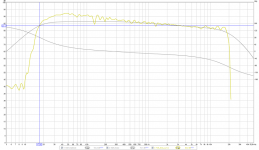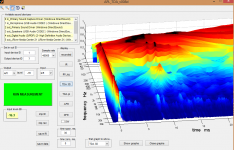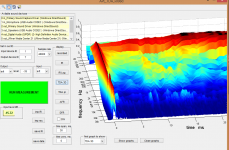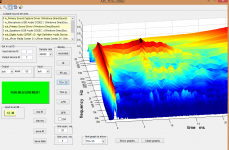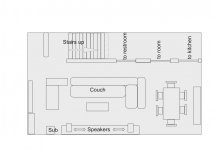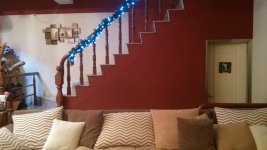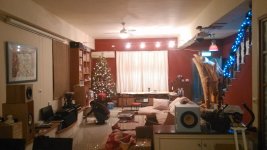Don't take that distance thing too literally, it's the longer time of flight, meaning it could be a wave, traveling to the side, then bounce back to the listening position. Seeing your left and right array I would try some loose damping panels between the right array and the door post to see if that clears up anything in the very early 2 ms.
If it does, it will work on the other side as well. This isn't meant as a permanent solution, don't worry, just trying to find the clues.
If it does, it will work on the other side as well. This isn't meant as a permanent solution, don't worry, just trying to find the clues.
.....So why do I consider adding subs? Piece of mind really, and headroom. But I don't want to miss all that low end fun. Its on more tracks than I ever knew. Now that I know what it can do, I don't want to be without it anymore.
Here's where the 17 Hz figure comes from:

This is how my EQ is set. Notice a roll off at the low end. I have made the mistake of not looking at that roll off carefully enough.
Hope Mayuri doesn't mind but I will take his graph as an example:
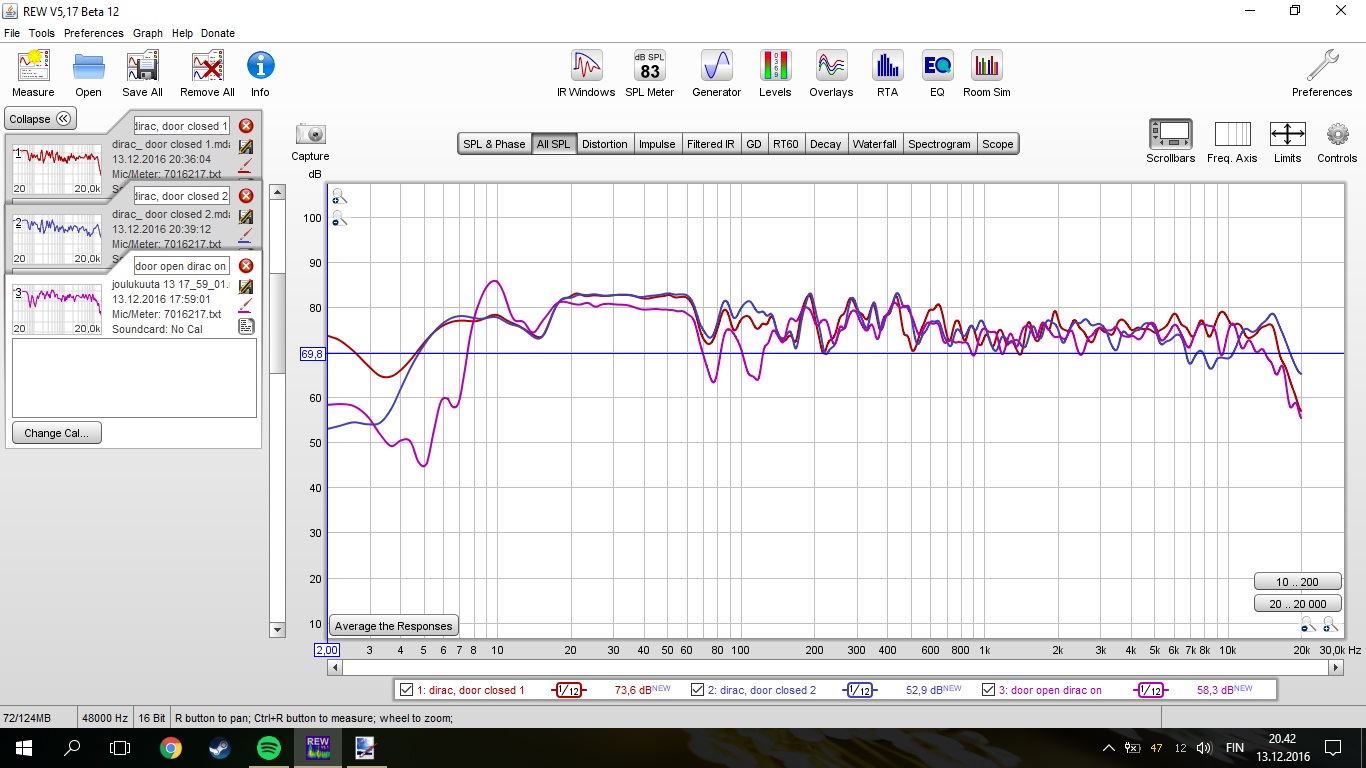
See how the EQ is set? With a big bump at 10 Hz? On ~98% of recordings he will be fine. But I bet he will get a scare sooner or later if he keeps that graph like this. Listen at 88 dB to 92 dB average and all of a sudden you think: what was that! Especially if he leaves the door open.
As far as i know the the softer the roll off filters for a given band-pass (read audio band) the less errors as ringing tails and better the timing is, therefor could we roll off 1. order as with OB or improve on 2.order BW as sealed box perform to a Bessel 2. order that is little softer roll then it would be preferable. In below have traced above TC9 lines curve overlaid with approximate B&K curve band-pass 17Hz BW2 - 20kHz BW2 and they cross actually at 17Hz for B&K -3dB point. Up in HF how real roll off slope are we probably can't conclude further without have to sweep with much higher sample rates and maybe needs better microphones too.
Do you believe in softer slopes improve on sound stream quality and what is meant about "mistake of not looking at that roll off carefully enough".
Agree that realism improve very much having real amplitude down at very low frq and good timing although sometimes think about the timing thing that it would probably be even better we had exactly same slope and timing including excess phase from XO's as a given track was mastered to be in close to same audio situation.
By the way talking low frq rumbling or DC thumbs the track we auditioned on TC9 lines and that sounded crazy good "Stephen Stills - Treetop Flyer" seems has a lot of that low end when looking at my woofer.
Attachments
Last edited:
OK, Thanks guys. Headroom and explosions, about what I figured. 
I do understand about the low, low end adding ambiance. About 30 years ago when I discovered systems that could play solidly and cleanly down to ~25Hz the effect was amazing. Not every recording, but with many you'd get a very real sense of the room or the venue that other systems did not give you. That's a fun sensation and adds a lot to the "You are there" illusion.
On the flip side, at work we often have to deal with some less than stellar videos. There can be so much low end junk on those recordings that we have to high pass them at 80 or 100 Hz just to be usable. Pretty obvious that they were mixed on little desktop speakers with no bass. They never heard the junk.
That doesn't have a lot to do with home Hi-Fi, except you'll often hear radio stations that obviously mix on small monitors. Their announcements, news and live will have a lot of low end noise. I'm sure they never hear it.
There is treasure down there, but also a lot of trash.
I do understand about the low, low end adding ambiance. About 30 years ago when I discovered systems that could play solidly and cleanly down to ~25Hz the effect was amazing. Not every recording, but with many you'd get a very real sense of the room or the venue that other systems did not give you. That's a fun sensation and adds a lot to the "You are there" illusion.
On the flip side, at work we often have to deal with some less than stellar videos. There can be so much low end junk on those recordings that we have to high pass them at 80 or 100 Hz just to be usable. Pretty obvious that they were mixed on little desktop speakers with no bass. They never heard the junk.
That doesn't have a lot to do with home Hi-Fi, except you'll often hear radio stations that obviously mix on small monitors. Their announcements, news and live will have a lot of low end noise. I'm sure they never hear it.
There is treasure down there, but also a lot of trash.
Right in front of me all long!
That makes sense. Now these graphs are starting to connect to something I can understand. These reflection drawings come to mind:
Sensible Stereo Recording
I will try some treatments between the side corners and the speakers. I will see if I can dig something up this week end...
Don't take that distance thing too literally, it's the longer time of flight, meaning it could be a wave, traveling to the side, then bounce back to the listening position.
That makes sense. Now these graphs are starting to connect to something I can understand. These reflection drawings come to mind:
Sensible Stereo Recording
I will try some treatments between the side corners and the speakers. I will see if I can dig something up this week end...
Do you believe in softer slopes improve on sound stream quality and what is meant about "mistake of not looking at that roll off carefully enough".
By that I mean that having the slope too gentle on the low end can really byte you on some material. It could cause wildly flapping cones if you're not careful. The slope has been made a little more steep to avoid such behaviour. That's done without too much phase changes as I do have that choice.
I kept the shape of the frequency curve up till 17 Hz, but deliberately went a little steeper lower than that as that could damage my setup (it would need more cone area and/or x-max than I have to offer, as well as amp power)
That makes sense. Now these graphs are starting to connect to something I can understand. These reflection drawings come to mind:
Sensible Stereo Recording
I will try some treatments between the side corners and the speakers. I will see if I can dig something up this week end...
Could be something temporary to figure out what's causing what. I took it a little too far maybe

Lucky for me, this particular test didn't solve anything. But hunting the room made me aware of most bumps and phase shifts out in the room. Another thing to check, an impedance curve of the speakers in the complete enclosure.
Every wiggle in the impedance curve can be the cause of an FR disturbance and as a result, a phase wiggle. Compare it to the driver in free air to have/give you a base line to compare with (I actually have 50 base lines
Most will probably think I'm crazy, but all details count when you want great results. Obviously your enclosure shape could also improve. You may want to use basic materials to see what that could do. Like foam pipe insulation cut in quarters or halves to round a corner. In preparation of your next build.
I deliberately kept my enclosure shape small, but round, An ellipse as seen from above, with a smooth transition from cone to the outer enclosure shape. Not ideal, better than doing nothing. I wanted to keep them narrow, because it appears 2 types of enclosures do well of making speakers disappear. Very small ones or very wide ones. I looked up many speaker reviews to see if it has merit. Narrow round enclosures seemed to do very well in that department.
If I'm rattling to much, just say so
OK, Thanks guys. Headroom and explosions, about what I figured.
I do understand about the low, low end adding ambiance. About 30 years ago when I discovered systems that could play solidly and cleanly down to ~25Hz the effect was amazing. Not every recording, but with many you'd get a very real sense of the room or the venue that other systems did not give you. That's a fun sensation and adds a lot to the "You are there" illusion.
On the flip side, at work we often have to deal with some less than stellar videos. There can be so much low end junk on those recordings that we have to high pass them at 80 or 100 Hz just to be usable. Pretty obvious that they were mixed on little desktop speakers with no bass. They never heard the junk.
That doesn't have a lot to do with home Hi-Fi, except you'll often hear radio stations that obviously mix on small monitors. Their announcements, news and live will have a lot of low end noise. I'm sure they never hear it.
There is treasure down there, but also a lot of trash.
I figured you'd have had that kind of experience. Loved to read your Hiraga stories as my goal was to get the "You are there" type of performance. I came across some fun back and forth posts between you and Geddes here and there
Just so anybody else feels good about their not so horrible rooms, here's mine, which is the living room... a complete audio nightmare.
It is roughly 5m x 9m. three doors leading to a bathroom, a kitchen and a mall room, plus a staircase right behind the couch... like I said... horrible.
I don't have any other options, so this has to do for now, until I change my job or my house!
I have a MAJOR reflection from the back wall (not shown in this picture) which is cement, about 1m behind my couch. There is no possibility of adding an absorption panel there, so I have to live with it. For this measurements, I stacked a bunch of pillows on the wall behind, so that huge peak is not showing. But it is a red spike at 10ms and 10k... and located in front of that other mountain at 1k and 10ms.
Also, the other reflection in the middle at about 1k is from the ceiling. After testing, a little like wesayso and his foam/fiberglass pads in the picture above, and moving them around, I found that it is indeed from the ceiling... again, nothing much I can do there.
One interesting bit is I tried a ported enclosure, then the same driver mounted as a dipole (a la Nola Brio) and the dipole seems to look better than the front firing ported box.
Those measurements had no EQ at all, just RAW drivers, as I couldn't get TDA and the JRiver driver to play along.
There is a sub located in a corner of the room.
First picture is the ported box, second is the dipole. 3rd picture is the dipole with a sealed sub playing right under it. Seems it was interacting with the corner sub...
It is roughly 5m x 9m. three doors leading to a bathroom, a kitchen and a mall room, plus a staircase right behind the couch... like I said... horrible.
I don't have any other options, so this has to do for now, until I change my job or my house!
I have a MAJOR reflection from the back wall (not shown in this picture) which is cement, about 1m behind my couch. There is no possibility of adding an absorption panel there, so I have to live with it. For this measurements, I stacked a bunch of pillows on the wall behind, so that huge peak is not showing. But it is a red spike at 10ms and 10k... and located in front of that other mountain at 1k and 10ms.
Also, the other reflection in the middle at about 1k is from the ceiling. After testing, a little like wesayso and his foam/fiberglass pads in the picture above, and moving them around, I found that it is indeed from the ceiling... again, nothing much I can do there.
One interesting bit is I tried a ported enclosure, then the same driver mounted as a dipole (a la Nola Brio) and the dipole seems to look better than the front firing ported box.
Those measurements had no EQ at all, just RAW drivers, as I couldn't get TDA and the JRiver driver to play along.
There is a sub located in a corner of the room.
First picture is the ported box, second is the dipole. 3rd picture is the dipole with a sealed sub playing right under it. Seems it was interacting with the corner sub...
Attachments
Am I way off thinking your sub isn't all that aligned, What corner is it playing at, The nect door neighbours  . Sorry, couldn't resist. I remember "seeing" this room in measurements. It will always be a difficult room. What's the ceiling like? Maybe you should try to fire the speakers in a different direction... Have you ever just laid a pair of speakers on their back? (obviously not the Brio Trio)
. Sorry, couldn't resist. I remember "seeing" this room in measurements. It will always be a difficult room. What's the ceiling like? Maybe you should try to fire the speakers in a different direction... Have you ever just laid a pair of speakers on their back? (obviously not the Brio Trio)
Most will probably think I'm crazy, but all details count when you want great results...
If I'm rattling to much, just say so.
If anything, You have proven that the details do indeed matter and You have shown us how to see them with these measuring tools. So ramble on, I am listening.

I am glad, for the sake of aesthetics and your family, that the acoustic insulation on top of your arrays did not work. What we audio lovers do for the ultimate sound!
We are thinking along the same line for cabinet shapes... I am thinking either circular columns or half circular columns, where the flat side would be right up against the side walls and the baffle would wrap around the door jam on the arch side (right speaker) and merge into the bay window on the other side (left side). This latter design might be too customized to this room, if I ever relocated, I would need to build new cabinets. Or maybe it would be a selling point to the house - "built in architectural sound system". We will see what I can learn when I start playing with some insulation.
I have seen people put foam on their baffles to reduce reflections. This would not be my first choice aesthetically, but wondering if any of You have played with that concept or not?
I do not have the impedance curve for this system, no way to measure at the moment. Could get some basic components so I can use my M-Audio inputs, but I know care must be taken, as one can fry the inputs doing this wrong. But I want a way to figure this out, as it will help me perfect my cabinets...
Now I am seeing why You guys like those colored APL_TDA graphs...
Last edited:
Am I way off thinking your sub isn't all that aligned, What corner is it playing at, The nect door neighbours. Sorry, couldn't resist. I remember "seeing" this room in measurements. It will always be a difficult room. What's the ceiling like? Maybe you should try to fire the speakers in a different direction... Have you ever just laid a pair of speakers on their back? (obviously not the Brio Trio)
Here's a rough sketch of the living room... that should say it all. Not much to play around. Ceiling is at 3 meters.
Attachments
I have used foam, beach towels, fake fur and felt - but not all at once.I have seen people put foam on their baffles to reduce reflections. This would not be my first choice aesthetically, but wondering if any of You have played with that concept or not?
All of these work to smooth the response. You can hear it and measure it. The thicker the better, generally, but of course that's frequency dependent.
You are correct, it's difficult to make it look good.
Here's a rough sketch of the living room... that should say it all. Not much to play around. Ceiling is at 3 meters.
It gives me no clue why that sub is turning up that late in your APL plots. Or am I looking at it all wrong. The 2D plots make it easier to see what part is played at what timing, it's no surprise that room is messy with the hard surface. Though improving the timing might help clear it up some.
Hard to judge what we're looking at though. That last graph shows a build up of low energy that seems to peak at 30 ms or more, That's not the sub, is it?
If it is, the distance to ear is almost similar to the distance to the speakers, why would it be that late. The other plots are harder to make out. A flat 2D view might help.
Is the sub sealed or ported, what range does it play...
I do not have the impedance curve for this system, no way to measure at the moment. Could get some basic components so I can use my M-Audio inputs, but I know care must be taken, as one can fry the inputs doing this wrong. But I want a way to figure this out, as it will help me perfect my cabinets...
I used a known resistor plus a simple wiring scheme for REW found on Google. You don't need to find the driver TS parameters, just the wiggles in the impedance curve. As it wasn't easy to find a DATS tool nearby and I didn't need the TS info I figured I could get by with this simple solution.
I heard/read about the stories of blowing up inputs and for that reason I used an old laptop. I still keep it around for these duties. I wouldn't like to blow up my Asus card.
Last edited:
I'll measure without the sub as soon as I can.
Ceiling is flat cement, a small ceiling fan in the middle, in front of the right speaker (when looking at them). Big cement beam going front to back between couch and dining table, 25cm wide, 50cm high.
I don't expect a miracle. This room is a nightmare for reflections and bass escaping through the staircase.
Ceiling is flat cement, a small ceiling fan in the middle, in front of the right speaker (when looking at them). Big cement beam going front to back between couch and dining table, 25cm wide, 50cm high.
I don't expect a miracle. This room is a nightmare for reflections and bass escaping through the staircase.
The issue here is not even WAF related.
That wall leads to the bathroom the students are using here. Kids LOVE touching things and if I were to put a dampening panel there, it would get so dirty so fast...
Plus, the wall is opened to the staircase going up, it's not a nice flat wall.
Here's the situation:
That wall leads to the bathroom the students are using here. Kids LOVE touching things and if I were to put a dampening panel there, it would get so dirty so fast...
Plus, the wall is opened to the staircase going up, it's not a nice flat wall.
Here's the situation:
Attachments
- Home
- Loudspeakers
- Full Range
- The making of: The Two Towers (a 25 driver Full Range line array)
